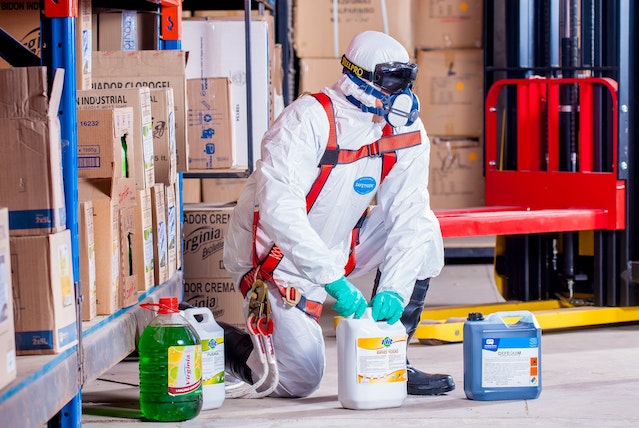
What is the pH scale? It probably stands for potential of hydrogen and it shows how much hydrogen is in a substance.
The pH scale is written with a capital H because the symbols for the elements are always written with a capital. However, when the scale was invented by a Danish chemist called Soren Peter Lauritz Sorensen, he wrote a lowercase p with a tiny capital H next to it. Like this: pH• He never actually said what the “p” stands for, which is why people say it probably stands for potential. He was working with the potential of hydrogen and he was working in French, German, and Danish, where the word potential starts with a p in all of the languages. It could also be “power”, which also starts with a p in all three languages, but potential is more likely.
The pH scale goes from 0 to 14, with 7 in the middle. Solutions that have a pH of between 0 and 7 are acidic and solutions with a pH of between 7 and 14 are alkaline. Solutions with a pH of 7 are neutral. You can have very acidic solutions that have a pH lower than 0 and you can have very alkaline solutions that have a pH of higher than 14. The scale is logarithmic, which means each level is ten more than the one below it. Something with a pH of 2 is ten times more acidic than something with a pH of 3.
You can test the pH of a solution by using a solution that changes color with the pH. You can use different substances, but most general testing is done with a universal indicator. This is either a piece of paper that has been soaked in chemicals or a solution. The chemicals that are in the solution are 1-propanol, phenolphthalein, sodium hydroxide, methyl red, bromothymol blue, sodium bisulfite, and thymol blue. The different substances react to different levels of acidity of alkalinity and change color. Red is a strong acid. Orange to yellow is a weak acid. Green is neutral. Blue is a weak alkali. Indigo to violet are a strong alkali. Since 1934, it has also been possible to work out the pH of a solution electronically.
So, why is pH called the potential of hydrogen? Because it is measuring the presence or lack of hydrogen ions and the presence or lack of hydroxyl ions. When a solution is neutral, it has exactly the same number of hydrogen ions and hydroxyl ions. Water is a neutral solution. If the solution has more hydrogen ions, it is acidic and if it has more hydroxyl ions, it is alkali.
Let’s look at what an acid is. When some substances are dissolved in water, the water breaks the bonds holding the molecules together and hydrogen ions are released. An ion is a molecule that has a charge, either because it has more protons than electrons or more electrons than protons. In this case, the hydrogen ion is positively charged because it loses an electron when the bonds are broken, and it has one more proton than electrons. This is why many acids are corrosive. Atoms always want to be neutral, and the hydrogen ions desperately need to get back that electron. If you put acid on something, it will pull the electrons out of it, causing it to break down and corrode. Some materials will produce more and more hydrogen ions, making them stronger acids.
An alkaline solution is similar to an acid, but instead of the water causing the substance to release hydrogen ions, the alkaline solution releases hydroxide ions, which are negatively charged. They have lost a proton and they have one more electron. Alkaline solutions are also corrosive because they are trying to get protons and they will pull them out of anything they land upon. This is why, when equal strength acids and alkalis are put together, they neutralize each other because the acids are looking for the electrons that the alkaline solution has and the alkali is looking for the electron that the acid has.
The word acid comes from the Latin word acidus, which meant sour. Most acids are sour, but you wouldn’t want to taste too many of them. The word alkaline comes from the Arabic al qaliy, which meant calcined ashes, a kind of paste made from burned plant ashes. And this is what I learned today.
Photo by Pixabay: https://www.pexels.com/photo/action-adult-boots-boxes-209230/
Sources
https://en.wikipedia.org/wiki/PH
https://en.wikipedia.org/wiki/Universal_indicator
https://www.usgs.gov/media/images/ph-scale-0
https://thedeanacademy.org/wp-content/uploads/2019/09/Science-KO-Acid-and-alkali.pdf
https://www.britannica.com/science/pH
https://www.dundeesciencecentre.org.uk/acids-and-alkalis
https://www.qrg.northwestern.edu/projects/vss/docs/propulsion/1-what-is-an-ion.html
https://www.news-medical.net/life-sciences/What-Makes-Something-Acidic-or-Alkaline.aspx
https://www.toppr.com/ask/en-jp/question/why-do-acids-not-show-acidic-behaviour-in-the-absence/
https://en.wikipedia.org/wiki/Alkali
https://chemistry.stackexchange.com/questions/41783/why-are-acids-corrosive
